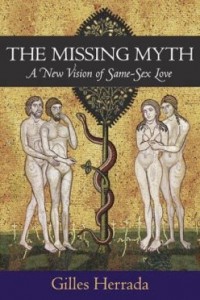 The Missing Myth: A New Vision of Same-Sex Love
The Missing Myth: A New Vision of Same-Sex Love
by Gilles Herrada
SelectBooks.
366 pages, $19.95
HOMOSEXUALITY is almost always treated as a mystery and an issue of contention. Why isn’t it just a fact of human life, like red-headedness or left-handedness? Why do we even have to ask where it comes from or what gives rise to it? Is it learned, genetic, or hormonal? Is it caused by structures in the brain or quirks and traumas of psychological development, a result of evolution? These familiar questions provide the context for Gilles Herrada’s wide-ranging discussion of current scientific discoveries and socio-cultural dynamics.
Herrada is a molecular neurobiologist, a specialist in the genetics of pheromones turned philosopher and Renaissance Man asking some big questions about science, human meaning, and the nature of consciousness. This book really is a kind of gay “theory of everything,” an exposition of how an array of factors—science, religion, psychology, gay culture, gay sex, pheromones, queer theory, sodomites, sexologists, gay liberation, and love—fit together into the “new vision” referred to in the subtitle.
Herrada is French but now lives in New York City. His important influences include Michel Foucault and Ken Wilber, along with Joseph Campbell and Pierre Teilhard de Chardin. The influence of Wilber’s “Integral Approach” shows in the book’s division into the “big three” conversations: “the true,” “the good,” and “the beautiful.” Like Wilber, Herrada intends to integrate as many elements of human reality as possible into the vision he presents. The Missing Myth sets out to report on the latest science and to offer a satisfying theory of homosexual etiology grounded in molecular biology, and it goes on to address history, culture, religion, myth, meaning, politics, and activism in search of the “new vision.”
Herrada starts with the biology. Reinterpreting a vast body of data emerging from molecular genetics, brain imaging, and so on, Herrada challenges the “gay gene” hypothesis and posits that the spectrum of sexual orientations is better explained by what he calls the “loose switch”: a pheromone-based biogenetic control that’s probably located in the hypothalamus, an area of the brain involved in setting sexual attraction in utero. Herrada contests the consensus that reproduction is the primary goal of sex. Sex among higher primates—whether hetero- or homosexual—is mostly about social cohesion, bonding, and even friendship. In that context, homosexuality is hardly an inexplicable oddity. It is, he concludes, “biologically primed and culturally shaped.”
The section on “the Good” addresses moral and religious perspectives. A central point is that modern homosexuality is sui generis. In pre-modern cultures, homosexuality was sometimes accepted, even honored, but it was always characterized by status differences between the partners. For the Greeks the difference was transgenerational, a relationship between an adult male and a pubescent one; it was more about mentoring than about romantic love. In the “two-spirit” model, observed among some Native American and other aboriginal cultures, such as the hijra model in India, the model was gender-related: sex took place between a masculine, dominant male and a feminized, submissive one in a basically heterosexual dynamic. Modern homosexuality, in contrast, involves love and sex between equals, where sexual versatility is honored and long-term, loving relationships—not just sexual conquest—are valued. It can perhaps be traced as far back as Walt Whitman’s poetry but only comes into its own after World War II.
With the rise of Christianity in the West, any concept of normal, natural homosexual feelings and behaviors simply disappeared. This is the “missing myth” of the book’s title. The story of Sodom and Gomorrah dominated all discourse on the matter for centuries, even though the actual biblical story had little to do with homosexuality.
The section on “the Beautiful” moves from mind to spirit: from the logos to the mythos, as it were. Modern homosexuality appears as an oddity and a mystery to be explained because we have no collective myth, no general concept, of what homosexuality—specifically, modern gay consciousness—might mean in the great scheme of things. What’s needed today is a mythos that can explain homosexuality and gender diversity within the evolution of consciousness and the healthy functioning and ecology of human life.
Playing off the tripartite scheme of body, mind, and spirit, Herrada connects them, respectively, to the three Greek words for love: eros, agape, and philia. What’s key to philia is mutuality and sameness. Modern homosexual love represents philia’s full embodiment such that homosexual love is free from any purely biological imperative, making it more human, more spiritual. “Homosexual love is one of the many faces of the divine,” Herrada proclaims in his conclusion.
The Missing Myth is itself a contribution to this mythopoetic effort—engaging, interesting, relatively easy to read, and believable. The “new myth,” after all, isn’t going to be a set of quasi-historical stories about supernatural beings. There’s not going to be a new world savior whom everybody recognizes as God. The new myth will have to be a concept of human life that embraces all world saviors, all religions, and all scientific discoveries. Such an all-inclusive vision of what it means to be human will naturally include homosexuality as an integral part of the big picture. That we can recognize it as such is an achievement in the evolution of human understanding. Herrada’s book, for all its scientific language and barrages of facts, is a contribution to this comprehensive theory of everything.
Toby Johnson is author of Gay Spirituality: Gay Identity and the Transformation of Human Consciousness.





